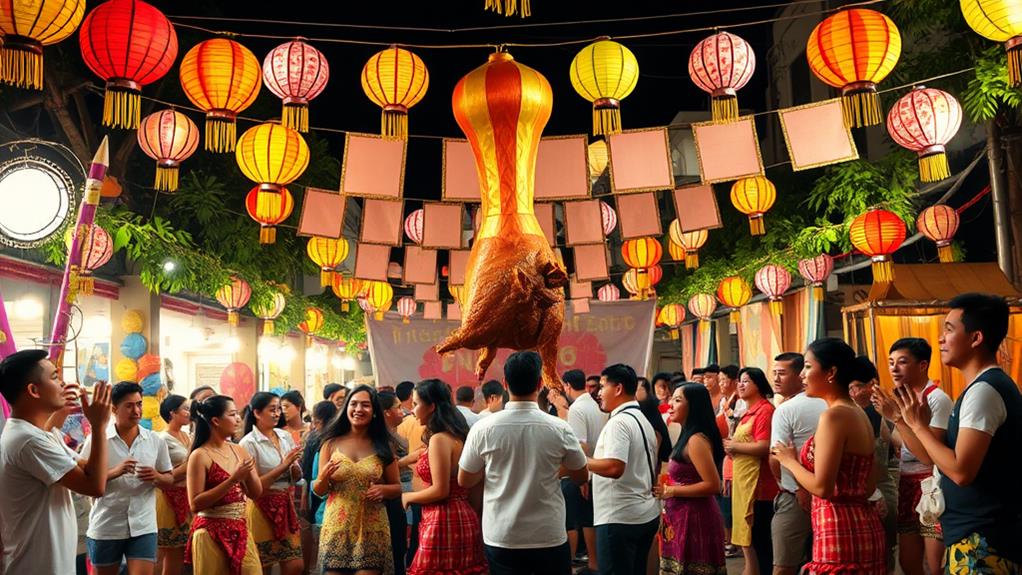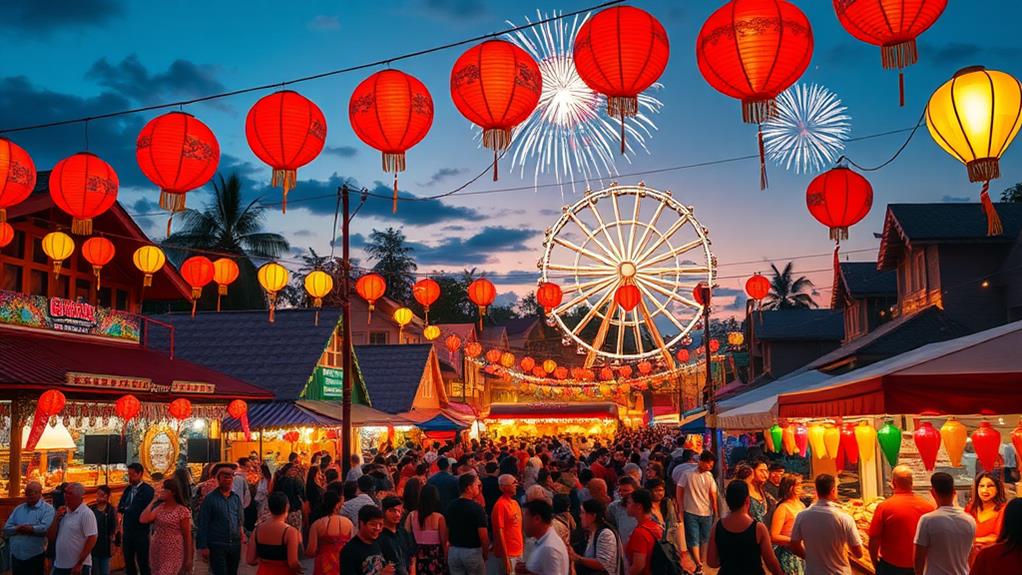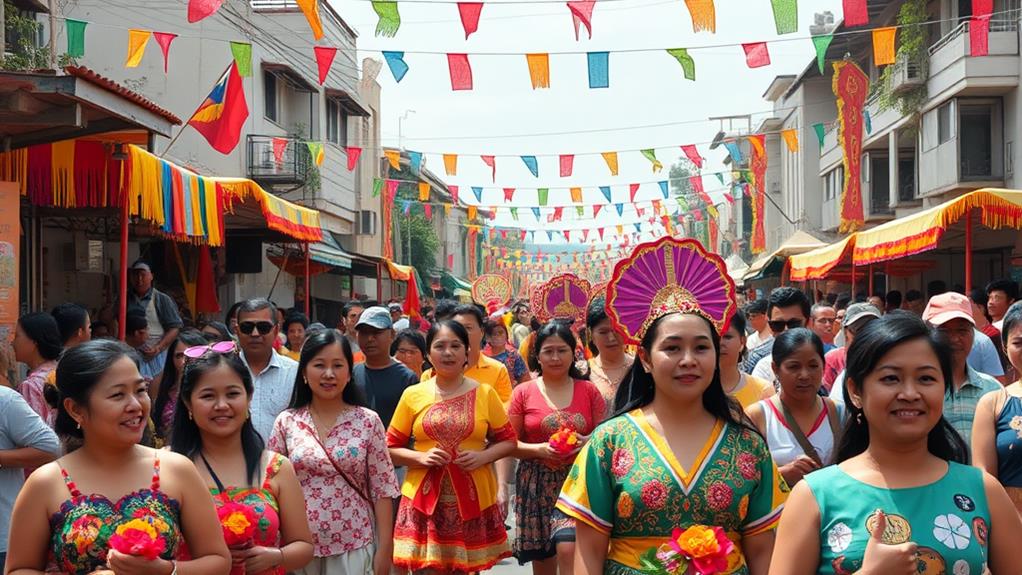Filipino fiestas are a celebration of vibrant culture and community. The infectious energy of these events is palpable, with a mix of vibrant colors, eclectic sounds, and mouth-watering aromas that showcase the country's rich heritage.
Traditional dance performances are a key part of Filipino fiestas. Expect to see lively processions and communal feasting on popular dishes like lechon, a whole roasted pig, and adobo, a savory stew made with meat or seafood.
These events also feature unique cultural traditions and games that foster community bonding and participation.
The Philippines has over a hundred festivals to choose from. One of the most iconic is the Sinulog Festival, which celebrates the country's rich history and culture.
No matter which festival you choose to attend, you'll experience the warm spirit of Filipino hospitality that will leave you wanting more.
Discovering Filipino Fiesta Traditions

Filipino fiestas are vibrant celebrations that showcase the country's rich cultural heritage. These events are an integral part of the Filipino culture and are characterized by a kaleidoscope of colors, sounds, and aromas. The streets are adorned with banderitas, which are small flags that create a lively atmosphere.
The main event of a Filipino fiesta is a grand procession. This procession features the patron saint's image, which is paraded through the streets accompanied by music and dance. For example, the Sinulog Festival in Cebu features a grand procession of the Santo Niño, a statue of the Child Jesus. This event is a significant part of the festival and showcases the country's deep Catholic roots.
Filipino fiestas also feature traditional food and games. The air is filled with the scent of traditional dishes, such as lechon and adobo, which are popular Filipino foods.
These events also feature various games and activities, such as the "palo sebo" game, which is a traditional Filipino game that involves climbing a greased pole. These games bring the community together and foster a sense of camaraderie.
Participating in a Filipino fiesta is a unique and unforgettable experience. It provides an opportunity to immerse oneself in the country's vibrant culture and traditions. By participating in these events, one can gain a deeper understanding of the Filipino culture and create lifelong memories.
Cultural Significance of Filipino Fiestas
Filipino fiestas are a vital part of the country's cultural heritage. These celebrations are deeply intertwined with the country's history and traditions, specifically the feast days of patron saints. For example, the Sinulog Festival in Cebu honors Santo Niño, while the MassKara Festival in Bacolod honors San Sebastián. Each fiesta showcases the community's connection to their heritage through vibrant decorations and festivities.
Community bonding is a key aspect of Filipino fiestas. These celebrations serve as a platform for communal bonding, where Filipinos extend open invitations to neighbors and guests to partake in shared meals. This highlights the Filipino value of hospitality and emphasizes the importance of community.
For instance, during the Flores de Mayo festival, families gather to share meals and participate in processions featuring the patron saint's image.
Religious rituals are an integral part of Filipino fiestas. The celebrations feature various religious rituals, such as mass and processions, which reinforce community devotion and faith.
These rituals, like the Eucharistic processions during the Manila Cathedral's Fiesta, strengthen the community's connection to their patron saints and faith.
Attending a Filipino fiesta offers a unique cultural experience. By participating in a fiesta, one can gain a deeper understanding of the country's customs and traditions. The vibrant atmosphere and spiritual significance of these celebrations make them an essential part of Filipino culture and identity.
Vibrant Celebrations and Activities

A Filipino fiesta is a celebration filled with vibrant colors, infectious laughter, and lively music. The air is electric with excitement, and the smell of delicious food wafting through the air adds to the festive atmosphere.
Traditional Dance Performances are a crucial part of Filipino fiestas. These performances showcase the rich cultural heritage of the Philippines, with dancers performing traditional dances like the Tinikling and the Carinosa.
These dances are notable for their colorful costumes and lively movements, which contribute to the festive atmosphere.
Lively processions are another feature of Filipino fiestas. Local school bands and traditional dancers participate in these processions, which provide a great way to experience the energy and excitement of the fiesta.
Games and contests are also a key part of Filipino fiestas. These activities are fun for all ages and include traditional Filipino games and modern competitions.
Examples of these games include traditional Filipino games and modern competitions that keep participants on their toes.
Exploring Filipino Fiesta Cuisine
Filipino Fiesta Cuisine Offers a Rich Culinary Experience
Filipino fiestas are known for their vibrant celebrations, activities, and rich culinary heritage. Food plays a central role in these celebrations, showcasing the country's diverse cultural influences. A variety of dishes, such as lechon, adobo, and pancit, offer a flavor explosion that highlights the country's culinary diversity.
Filipino Hospitality is Reflected in Communal Sharing of Food
During fiestas, the open house concept encourages communal sharing of food. This setup allows guests to experience the warm hospitality of the Filipino people, as they share meals with neighbors and friends.
Regional specialties, such as Visayas' sweet lechon and Luzon's flavorful kare-kare, add to the excitement of the culinary journey.
Food Preparation is a Family Affair
Food preparation is often a family affair, reflecting the country's rich cultural traditions and the importance of family and community.
This collaborative approach to cooking provides a glimpse into the country's values and highlights the significance of family bonding during fiestas.
Must-Experience Fiestas in Philippines

The Philippines is known for its vibrant fiestas, which showcase its rich cultural heritage. Every year, numerous fiestas take place across the country, drawing millions of attendees.
The Sinulog Festival is one of the most popular fiestas in the Philippines. It's held on the 3rd Sunday of January in Cebu and honors Santo Niño. This festival features vibrant street parties with over a million attendees, making it an event to experience.
Another must-visit festival is the Ati-Atihan Festival in Kalibo. Celebrated in January, this 18-day festival showcases the country's tribal heritage. Participants paint their faces with black soot and wear colorful costumes, adding to the lively spirit of the festival.
The MassKara Festival in Bacolod is also a notable event. Occurring on the 4th Sunday of October, this festival is famous for its smiling masks and street dancing. Thousands of locals and tourists attend the energetic parades, making it a popular destination.
Other notable fiestas in the Philippines include the Panagbenga Flower Festival in Baguio and the Pahiyas Festival in Quezon.
Panagbenga takes place every February, while Pahiyas Festival is celebrated on May 15th. These events feature colorful decorations made from rice and local produce, providing a glimpse into the country's diverse culture and traditions.
Travel and Fiesta Etiquette Tips
Attending a Filipino Fiesta: Etiquette Tips
When attending a Filipino fiesta, bring a small gift or food item to share, reflecting the spirit of generosity and community bonding. This gift can be a dessert, a fruit, or a snack that complements the festive atmosphere.
Dressing comfortably and in vibrant colors also helps to match the festive atmosphere.
Greeting and Interacting with Locals
When you arrive, greet locals with a warm smile and a "Mabuhay!" or "Kumusta?" (how are you?), as Filipinos are known for their hospitality and friendliness towards guests.
This greeting sets the tone for a respectful and enjoyable interaction with the locals.
Participating in Traditional Food Offerings
Be prepared to partake in traditional food offerings, as the open house concept means that guests are encouraged to join in and enjoy the meals provided by hosts.
This may include trying local delicacies such as adobo, lechon, or sinigang.
Respecting Religious Aspects
Respect the religious aspects of the fiesta, such as attending the mass and procession, as these elements are important to the community and reflect the cultural devotion intertwined with the celebrations.
By doing so, you show respect for the locals' traditions and values.
Experiencing the Authentic Spirit
By being mindful of these customs, you'll be able to spend time with locals and truly experience the authentic spirit of the fiestas.
This includes participating in lively activities, enjoying traditional food, and immersing yourself in the vibrant atmosphere of the fiesta.
What Traditional Filipino Ceremonies Should I Experience at a Filipino Fiesta?
When attending a Filipino fiesta, you should experience traditional filipino ceremonies frequency. Witness the vibrant and colorful Sinulog festival, join the Pahiyas festival to see beautifully adorned houses, and partake in the lively Ati-Atihan festival to immerse yourself in the rich cultural heritage of the Philippines.
Fiesta's Impact on Community Spirit

Fiestas Foster Community Spirit
Filipino fiestas play a significant role in bringing people together, creating a sense of community spirit. These celebrations encourage participation from both locals and visitors, uniting them through shared traditions and festivities.
Participation in Fiesta Activities Promotes Hospitality
Participating in fiesta activities, such as food offerings, promotes hospitality and generosity among community members. For example, the open invitation to partake in food offerings reinforces social bonds and creates a sense of belonging.
Sharing food together strengthens community ties.
Decorations and Celebrations Enhance Communal Pride
Colorful decorations, like banderitas, signal ongoing celebrations and create an inviting atmosphere that draws people together.
These decorations enhance communal pride and reinforce community spirit.
Additionally, the religious aspects of the fiestas, including mass and processions, emphasize collective faith and devotion, strengthening spiritual connections among participants.
Festive Activities Foster Camaraderie
Engaging in festive activities, such as games, contests, and street dancing, fosters camaraderie and creates lasting memories that enhance community ties.
Participating in these activities gives individuals a true taste of the community spirit that defines these vibrant celebrations.
Unique Fiesta Experiences to Treasure
The Philippines' vibrant fiestas offer a kaleidoscope of colors, sounds, and flavors that create lifelong memories.
Unforgettable Fiesta Experiences
The Philippines' fiestas showcase the country's rich cultural heritage through unique experiences.
1. Filipinos celebrate with energetic street performances through vibrant street dancing. These performances highlight their creativity and passion for dance.
The Sinulog Festival in Cebu, for example, features street dancers dressed in colorful costumes, dancing to rhythmic beats.
2. Savoring traditional dishes like lechon, adobo, and pancit is a key part of the Philippines' food festivals. These traditional dishes highlight the Philippines' diverse culinary delights.
The MassKara Festival in Bacolod, for instance, features a variety of food stalls offering a range of Filipino delicacies.
3. Participating in lively games and contests fosters a sense of togetherness and creates unforgettable memories.
Examples of these games include the obstacle course in the Panagbenga Festival in Baguio and the water games in the Pintados Festival in Tacloban.
4. Grand parades and processions blend spirituality and community bonding, making each fiesta unique.
The Ati-Atihan Festival in Kalibo, for example, features a grand procession of floats, marching bands, and street dancers.
Experiencing these unique fiesta experiences deepens one's understanding of the Filipino culture and the importance of community in their celebrations.
Questions and Answers
Why Is Fiesta Important in the Philippines?
Fiestas are vital to the Philippines' cultural identity. They play a significant role in fostering community bonding, as vibrant celebrations bring people together and showcase the country's rich heritage. For instance, the MassKara Festival in Bacolod City and the Sinulog Festival in Cebu City are two prominent fiestas that attract millions of visitors each year, strengthening social ties among locals and tourists alike.
Why Is It Important to Learn About the Philippine Festivals?
Learning about Philippine festivals is essential for understanding the country's rich cultural heritage and deep-rooted values. These festivals play a significant role in fostering community bonding by bringing people together through shared traditions and activities. For instance, the Sinulog Festival in Cebu showcases the country's vibrant culture through colorful street performances and traditional dances. Similarly, the MassKara Festival in Bacolod promotes unity and gratitude through street parties and colorful costumes. By learning about these festivals, one can appreciate the country's values and heritage in a vibrant and immersive way.
What Can You Say About Fiesta in the Philippines?
The Philippines is known for its vibrant fiesta traditions, rich in cultural significance. These traditions showcase the country's warm hospitality and strong sense of community spirit.
Fiestas in the Philippines usually feature colorful parades. These parades often include street performances, floats decorated with flowers and colorful fabrics, and marching bands. Mouth-watering local cuisine is also a key component of these celebrations. Traditional Filipino dishes like lechon (roasted pig), adobo (meat stew), and sinigang (sour soup) are often served during fiestas.
Lively music and dance performances are also a major part of these celebrations. The Tinikling, a traditional Filipino dance that involves tapping bamboo poles, is often performed during fiestas.
What Is the Famous Fiesta in the Philippines?
The Sinulog Festival and the Ati-Atihan Celebration are two of the most famous fiestas in the Philippines.
These festivals showcase vibrant Filipino culture through colorful parades and street dancing. The Sinulog Festival, held in Cebu, is a grand celebration honoring the Sto. Niño (Child Jesus), featuring elaborate floats and costumes. On the other hand, the Ati-Atihan Celebration in Kalibo, Aklan, is a reenactment of the arrival of Malay datus in the island of Panay, marked by indigenous Ati performers in traditional attire. Both events display the country's rich cultural heritage, drawing tourists and locals alike.